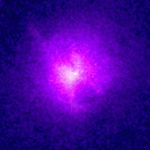December 9, 1999
CXC PR: 99-10
NASA's Chandra X-ray Observatory image of the Hydra A galaxy cluster has revealed a possible solution to a Herculean puzzle about the fate of the largest objects in the universe. For years astronomers have been searching unsuccessfully for large quantities of matter they believed must be flowing into the central regions of galaxy clusters. The Chandra image of Hydra A displays for the first time long snake-like strands of 35 million degree gas extending away from the center of the cluster. These structures show that the inflow of cooling gas is deflected by magnetic fields produced by explosions from a central black hole.
The X-ray image also reveals a bright wedge (shown in white) of hot multimillion degree gas pushing into the heart of the cluster. Like the legendary Hercules who had to contend with the multiple heads of the monstrous Hydra, astrophysicists now know they must deal with the effects of magnetic fields, star formation, rotation, and black holes if they are to understand what is happening in the inner regions of the galaxy cluster.
As the largest gravitationally bound objects in the universe, galaxy clusters provide crucial clues for understanding the origin and fate of the universe. Each large cluster such as Hydra A contains hundreds of galaxies and enough gaseous material to make a thousand more galaxies. One intriguing question has been the ultimate fate of this colossal gas reservoir. Early X-ray observations indicated that the gas in the inner regions of Hydra A should be cooling and slowly settling into the center of the cluster to form new galaxies or hundreds of trillions of dim stars. As astronomers began searching for this cool matter, they were puzzled to find that the new galaxies and stars were not detected in sufficient numbers.
The Chandra results on Hydra A, which is 840 million light years from Earth, may point to a resolution of this problem. The inflow of cooling gas may deflected by magnetic fields, and even pushed back into the cluster by explosions from the vicinity of a supermassive black hole at the core of the central galaxy.
"In Hydra, you can see the whole cycle," said Brian McNamara of the Harvard-Smithsonian Center for Astrophysics. "You have the hot gas cloud, the disk of material feeding the black hole, and the evidence that the explosion from the gas near the black hole is pushing the hot gas around."
Indeed, combined radio and X-ray observations suggest that a vast bubble of high-energy particles is pushing the hot gas aside, creating the Hydra-like loops of hot gas. Similar processes are likely to be at work in other galaxy clusters, and in newly forming galaxies that are collapsing from a cloud of gas. By using images with Chandra and other telescopes, astronomers may eventually conquer a "monstrous" problem of cosmic significance.
The Chandra image was taken with the Advanced CCD Imaging Spectrometer (ACIS) on October 30, 1999 in an observation that lasted about six hours. ACIS was built by Penn State Univ. and MIT.
This image will be available on NASA Video File which airs at noon, 3:00 p.m., 6:00 p.m., 9:00 p.m. and midnight Eastern Time. NASA Television is available on GE-2, transponder 9C at 85 degrees West longitude, with vertical polarization. Frequency is on 3880.0 megahertz, with audio on 6.8 megahertz.
To follow Chandra's progress, visit the Chandra site at:
NASA's Marshall Space Flight Center in Huntsville, AL, manages the Chandra program. TRW, Inc., Redondo Beach, CA, is the prime contractor for the spacecraft. The Smithsonian's Chandra X-ray Center controls science and flight operations from Cambridge, MA.
High resolution digital versions of the X-ray image (JPG, 300 dpi TIFF) and other information associated with this release are available on the Internet at:
NASA TV on the web
MEDIA CONTACTS
Donald Savage
Headquarters, Washington, DC
(Phone: 202/358-1547)
Steve Roy
Marshall Space Flight Center, Huntsville, AL
Phone: 256-544-6535
http://chandra.nasa.gov/
Dr. Wallace Tucker
Chandra X-ray Observatory Center
Harvard-Smithsonian Center for Astrophysics, Cambridge, MA
Phone: 617-496-7998
http://chandra.harvard.edu



